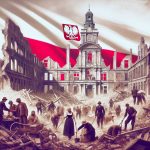
Poland has a rich and complex history, full of dramatic events like World War II, the brave Warsaw Uprising, life under Communist control, the groundbreaking Solidarity Movement, and its royal past.
These moments in history make great stories for movies. These films don’t just tell us about Poland’s past; they also dive deep into what it means to be human when facing tough times.
As we watch these stories, it’s interesting to think about how these historical events still affect the world today.
In a friendly chat, let’s explore how movies capture the essence of Poland’s history and what we can learn from them.
The Legacy of World War II
World War II drastically changed Poland, impacting its people and altering its place in the world. Many movies have explored this period, focusing on the bravery, the heartache, and the enduring spirit of the Polish people. These films give us a closer look at what happened during the war, showing both the big historical events and the personal stories of those who lived through it. They help us understand how the war changed individuals and the country as a whole, touching on themes like identity, the struggle for survival, and the lasting effects of conflict on society and individuals.
For example, movies like ‘The Pianist’ and ‘Ida’ mix real historical details with storytelling to bring the Polish experience of World War II to life. They show us the human side of history – the personal battles, sacrifices, and decisions people had to make. This approach makes the movies not just a way to remember Poland’s past but also a tool to teach and engage people worldwide. They offer insights into the complexities of the war and its lasting impact on Poland and its people.
The Warsaw Uprising
The Warsaw Uprising stands as a significant chapter in World War II, showcasing the Polish people’s unyielding courage and desire for independence. On August 1, 1944, the Polish Home Army, known as Armia Krajowa, launched a daring attempt to free Warsaw from German control. This move came as Soviet forces were nearing, and the Polish fighters wanted to reclaim their city and assert their nation’s sovereignty before potentially swapping one occupier for another.
The uprising was not just a military operation; it was a powerful statement of resistance against tyranny. It brought to light the complex interplay of strategy, politics, and ethics at a time when Poland was caught between the ambitions of Nazi Germany and the Soviet Union. The Polish fighters hoped not only to liberate their capital but also to secure a place for Poland as an independent and sovereign nation in the post-war world.
However, the rebellion faced brutal retaliation from the German occupiers. The Nazis responded with overwhelming force, leading to enormous loss of life and the deliberate demolition of Warsaw. This response underscored the harsh realities of the struggle for freedom, as well as the resilience of the Polish resistance. Despite facing insurmountable odds, the Polish Home Army fought valiantly for two months, although their efforts ultimately ended in tragedy.
The Warsaw Uprising is a poignant reminder of the cost of fighting for freedom and the complexities of international politics. It exemplifies the courage of the Polish people, their longing for independence, and the sacrifices they were willing to make. This event not only shaped Poland’s national identity but also serves as a testament to the human spirit’s persistence in the face of adversity.
By examining the Warsaw Uprising, we gain insights into the strategic and moral dilemmas faced by those resisting oppression. It also helps us understand the broader geopolitical dynamics of World War II and the cold calculations that sometimes guided the actions of the Allies. The uprising’s failure, due to lack of external support, particularly from the advancing Soviets who halted their advance as the battle raged, adds a layer of tragedy to the resistance’s heroic narrative.
In essence, the Warsaw Uprising teaches us about the complexity of resistance movements, the brutal costs of conflict, and the enduring desire for national sovereignty. It’s a powerful story of bravery, sacrifice, and the relentless pursuit of freedom, offering valuable lessons for understanding history’s profound impacts on national identity and the human condition.
Life Under Communist Rule
After World War II, Poland entered a new era under communist control. This period was a time of significant change as the Soviet Union-backed government aimed to mold the country’s society, politics, and economy according to Marxist-Leninist principles. The government took over industries and farms, trying to run them based on communist theories. This meant that the state owned everything from factories to the land people farmed on, a shift aiming to eliminate private business.
However, this approach also led to a crackdown on anyone who disagreed with the government. Freedom of speech was limited, and the government closely monitored cultural activities and the media to ensure they aligned with communist ideals. This censorship aimed to keep out Western influences and any anti-communist sentiment. The secret police played a crucial role in maintaining this control, instilling fear among the population by spying on and sometimes arresting those suspected of opposition.
Despite these efforts to modernize the economy and improve living standards, the reality was different. Poland faced shortages of basic goods, economic stagnation, and a general sense of disconnect between the people and the government. These issues weren’t unique to Poland; many countries under communist rule experienced similar problems.
This backdrop of economic difficulty and political repression set the stage for growing dissatisfaction. In Poland, this eventually contributed to the rise of movements that challenged communist rule, leading to significant political changes in the late 20th century.
In a more conversational tone, imagine living in a time and place where the government decides everything about your life, from the job you have to the food you eat. It’s a world where saying the wrong thing could get you in trouble and where the news you hear is carefully controlled. That was the reality for many people in Poland under communist rule. Despite the government’s promises of equality and prosperity, many found themselves facing hardships and a lack of freedom, laying the foundation for a push towards change.
The Solidarity Movement
In 1980, in the midst of economic troubles and strict communist control in Poland, a powerful movement called Solidarity emerged from the Gdańsk Shipyard. Initially formed as a labor union, Solidarity quickly grew into something much bigger—a widespread push for political change and human rights. This movement stood out because it used peaceful protests and large public gatherings to question the government’s power, setting off a chain of events that played a huge role in ending communist rule in Eastern Europe.
Solidarity’s impact went beyond just politics. It sparked a cultural revival, showing the strength and shared goals of the Polish people. This movement is a prime example of how people coming together can make a big difference, leading Poland toward democracy. It’s a reminder of the power of unity in facing oppression.
To better understand the importance of Solidarity, imagine a scenario where workers at a factory band together to demand better conditions. Now, amplify that by a whole country’s population, all demanding broader changes like freedom of speech and fair elections. That’s what Solidarity did. It transformed from a group concerned with workers’ rights to a national force advocating for liberty and justice.
One of the most remarkable things about Solidarity was its commitment to nonviolence. Instead of using force, they organized strikes and rallies that caught the world’s attention. This approach not only highlighted the issues within Poland but also gained international support, adding pressure on the communist regime.
Looking at Solidarity’s legacy, it’s clear that this movement wasn’t just a moment in history. It set the stage for a democratic Poland and inspired other movements across the globe. It’s a testament to the idea that peaceful, united action can lead to significant change. So, when we talk about Solidarity, we’re not just discussing a historical event; we’re looking at a blueprint for how to bring about social and political transformation peacefully.
Poland’s Royal Heritage
Poland’s history is deeply enriched by its royal past, with the Piast and Jagiellonian dynasties playing crucial roles in shaping the country as we know it today. These ruling families didn’t just expand Poland’s borders; they laid the foundations for its government, economy, and society. What set Poland apart in Europe was its elective monarchy system. Unlike hereditary monarchies, Poland allowed its nobles a say in choosing their king, introducing a unique blend of democracy into the mix.
This system wasn’t without its challenges. While it aimed to balance power between the nobility and the monarchy, it sometimes led to conflict. However, this dynamic also sparked a strong sense of national identity and unity among Poles. It’s fascinating to see how this blend of cooperation and competition among Poland’s early leaders helped forge the country’s distinct cultural and political identity.
For example, the election of King Kazimierz the Great in the 14th century stands out. His reign was marked by significant developments in law, education, and infrastructure, which had a lasting impact on Poland. He founded the University of Kraków, the oldest university in Poland, which became a center of Renaissance learning and culture. This move not only underscored the importance of education but also helped spread Renaissance ideas throughout Poland and beyond.
In discussing Poland’s royal heritage, it’s essential to remember the role of women in this history. Queens like Jadwiga of Poland played pivotal roles. Jadwiga’s marriage to Lithuania’s Grand Duke Jogaila led to the creation of a Polish-Lithuanian union, dramatically extending the nation’s territory and influence. Her devotion to Christian charity and education left a lasting legacy, highlighting the influence of royal figures beyond mere politics.
To truly appreciate Poland’s royal heritage, visiting sites like Wawel Castle in Kraków or the Royal Castle in Warsaw can be enlightening. These places offer a tangible connection to Poland’s past, allowing visitors to step back in time and experience the grandeur and complexity of its royal history.
Poland’s royal era, with its unique blend of democratic ideals and noble influence, has left an indelible mark on the nation. It’s a testament to how leaders, both men and women, navigated the challenges of their times to lay down the foundations for modern Poland. Understanding this history not only enriches our appreciation of Poland’s cultural heritage but also offers insights into the development of European societies as a whole.
Conclusion
Exploring Polish history through dramatic movies really opens our eyes to important moments that have helped shape what Poland is today. We get to see everything from the tough times during World War II and the Warsaw Uprising, to the challenging period under communist rule, and the big changes brought about by the Solidarity movement.
These stories are not just about the struggles, but also about the incredible strength and determination of the Polish people. On top of that, movies that dive into Poland’s royal past add another layer, giving us a fuller picture of Poland’s rich history and its lasting impact.






Comments are closed.